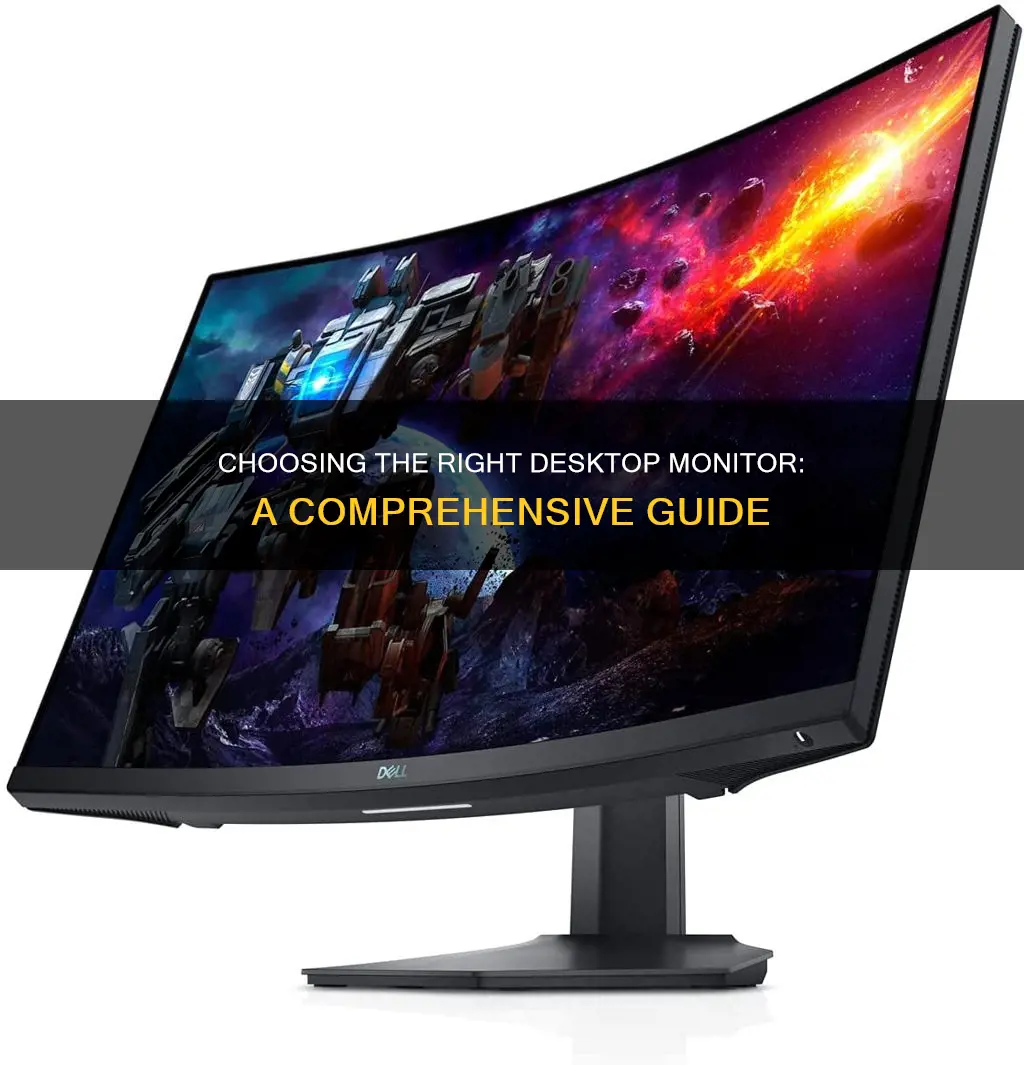
When it comes to buying a desktop monitor, there are a few things to consider. Firstly, what will you be using it for? If it's for everyday tasks like browsing the web, you can opt for a lower-priced monitor with a smaller screen. However, if you're a photographer, graphic designer, or video editor, you'll need a larger screen with higher resolution and better colour accuracy. Gamers, on the other hand, should look for monitors with fast refresh rates and low response times.
The resolution of a monitor is also an important factor to consider. A higher resolution will give you sharper images, but it's important to make sure your graphics card can handle it. The size of the monitor is also a matter of personal preference, but bigger isn't always better as you need to consider how much space you have and how the monitor will fit within your field of view.
There are different types of monitor panels available, each with its own advantages and disadvantages. In-Plane Switching (IPS) panels are the most common and offer good brightness, sharpness, and viewing angles, but tend to have disappointing contrast and black levels. Vertical Alignment (VA) panels have better contrast and black levels than IPS, but viewing angles are more limited. Twisted Nematic (TN) panels are typically used by gamers as they have very quick response times, but tend to have poor colour performance. Organic Light-Emitting Diode (OLED) panels offer the best contrast and black levels, as well as great viewing angles, but they are expensive and can suffer from permanent image retention over time.
Other features to consider include the refresh rate, which is the number of times the monitor updates with new information per second; the higher the refresh rate, the smoother the image. You should also look for a monitor with an adjustable stand so you can find a comfortable viewing angle, and one with a 100x100mm VESA mount so you can add a third-party monitor stand if needed.
| Characteristics | Values |
|---|---|
| Purpose | Gaming, professional or general use |
| Resolution | 1920 x 1080 (1080p, Full HD or HD), QHD, 4K, 5K |
| Size | 24", 27", 32", 34" ultrawide, 40" ultrawide |
| Refresh rate | 60Hz, 75Hz, 120Hz, 144Hz, 240Hz, 360Hz |
| Response time | 5ms, 2ms, 0.5ms |
| Panel type | TN, IPS, VA, OLED |
| Brightness level | 250 cd/m2, 350 cd/m2 |
| Contrast ratio | Dynamic contrast ratio, mega contrast ratio |
| Ports | HDMI, DisplayPort, DVI, VGA, USB-A, USB-C |
| Speakers | Yes, no |
| Stand | Fixed, adjustable (height, tilt, swivel, pivot) |
What You'll Learn

Budget monitors
When it comes to budget monitors, you can get a good deal without compromising on quality. Here are some options and features to consider:
Size and Resolution
While bigger monitors offer a more immersive experience, a 24-inch monitor is a good choice if you're low on desk space or prefer a smaller screen. A 27-inch monitor, on the other hand, offers a balance of size and price for most people and is ideal if you want something bigger than 24 inches but don't want to spend a lot. If you're looking for a larger viewing area, consider a 32-inch monitor, which is great for serious gamers and professionals in fields like photography, graphic arts, and video production.
In terms of resolution, a 1080p resolution is common in budget monitors, especially for 24-inch screens. However, if you're going for a larger monitor, consider a higher resolution like 1440p for 27-inch and 32-inch models, or even 4K for a sharper image and more screen real estate.
Panel Technology
There are three main types of panel technologies used in budget monitors: Twisted Nematic (TN), In-Plane Switching (IPS), and Vertical Alignment (VA). TN panels are typically more affordable and offer faster response times, making them a good choice for gamers. However, they may have poorer image quality when viewed from side angles. IPS panels provide better viewing angles and slightly faster response times than VA panels, but VA panels have the best contrast and image depth.
Refresh Rate and Response Time
A higher refresh rate means smoother and less choppy images, which is especially important for gamers. Look for a refresh rate of at least 75Hz, with 120Hz or higher being ideal for gaming. As for response time, shorter is better, and a response time of 5ms or less will reduce motion blur and ghosting.
Additional Features
Some other features to consider when choosing a budget monitor include:
- Adjustable stands: Look for monitors with stands that allow height and tilt adjustments for a comfortable viewing experience.
- Connectivity options: Ensure your monitor has the ports you need, such as HDMI, DisplayPort, or USB-C.
- Built-in speakers: While not all budget monitors have built-in speakers, this can be a nice addition if you want to use your monitor for watching videos or playing games.
- Blue light reduction: This feature reduces the amount of blue light emitted by the monitor, which can be easier on the eyes during extended use.
Monitoring Web History on Your ASUS Router
You may want to see also

Gaming monitors
Resolution
The resolution of a gaming monitor refers to the number of pixels displayed on the screen, typically given in terms of width x height. Common resolutions include Full HD (1920 x 1080), Quad HD (2560 x 1440), and 4K Ultra HD (3840 x 2160). A higher resolution means more pixels and a sharper, more detailed image. For gamers, a higher resolution can provide a more immersive gaming experience and allow for a larger field of view. It is also beneficial for multitasking, as it allows for multiple windows to be open side by side.
Response Time
The response time of a gaming monitor refers to how quickly a pixel can change its colour, and it is measured in milliseconds. A faster response time reduces the ghosting effect, which is a faint trail left on the screen from previous images. For gaming, a response time of 5ms or less is recommended to ensure smooth and blur-free gameplay.
Refresh Rate
The refresh rate of a gaming monitor refers to how many times per second the image on the screen is refreshed, and it is measured in hertz (Hz). A higher refresh rate means a smoother picture with less motion blur. Most monitors have a standard refresh rate of 60Hz, but for gaming, a higher refresh rate of 144Hz or more is preferred.
Viewing Angle
The viewing angle of a gaming monitor refers to how far off-centre you can view the screen before the picture quality degrades. This is important if you plan to play games with a crowd, as it ensures that everyone can see the screen clearly, even when sitting at an angle. A viewing angle of 178° or more is recommended for gaming.
Other Considerations
In addition to the specifications mentioned above, there are a few other features that can enhance your gaming experience:
- Panel Type: There are three main types of panels used in gaming monitors: TN (Twisted Nematic), IPS (In-Plane Switching), and VA (Vertical Alignment). TN panels offer the fastest response times and refresh rates, making them ideal for competitive gamers. IPS panels provide excellent colour reproduction and wide viewing angles, making them a good choice for solo gamers or those who prioritise graphics over performance. VA panels offer a balance between the two, with improved performance in dark scenes.
- Sync Technology: NVIDIA G-SYNC and AMD FreeSync are sync technologies that help reduce screen tearing and provide a smoother gaming experience. G-SYNC is compatible with NVIDIA graphics cards, while FreeSync works with AMD cards.
- Curved vs Flat: Curved gaming monitors provide an immersive gaming experience and can bring the edges of the screen into your peripheral vision, so you don't miss any details. Flat monitors are more common and usually more affordable.
- Size: The size of the gaming monitor is also an important consideration, as it will depend on your available space and budget. Larger screens can provide a more immersive experience, but they also tend to be more expensive.
With these specifications and features in mind, you can choose a gaming monitor that best suits your needs and budget.
Understanding Monitor Resolution: Know Your Display Definition
You may want to see also

Professional monitors
- Dell UltraSharp 27 4K USB-C Hub Monitor (U2723QE): This 27-inch 4K monitor offers a wide colour gamut, excellent ergonomics, and a full range of connectivity options, including USB-C. While it is priced higher than other options, it provides exceptional image quality and is ideal for professionals who require accurate colour reproduction.
- Apple Pro Display XDR: The Apple Pro Display XDR is a high-end option with exceptional colour accuracy and build quality. It offers a 6K resolution and stands out for its ability to dim individual screen areas, resulting in a theoretically infinite contrast ratio. However, it is designed specifically for Mac users and comes with a hefty price tag.
- BenQ SW321C PhotoVue: This 32-inch 4K monitor boasts an impressive colour gamut, covering 99% of the Adobe RGB colour space and 95% of DCI-P3. It is an excellent choice for photographers, video editors, and graphic designers, offering accurate colours and uniform brightness.
- BenQ PD2725U: The BenQ PD2725U is a 27-inch 4K monitor with exceptional colour accuracy and robust multitasking features. It supports Thunderbolt 3 connectivity and is reasonably priced, making it accessible to non-professionals seeking superior image quality.
- Arzopa M1RC: The Arzopa M1RC is a budget-friendly option with a 27-inch QHD display and a high refresh rate of up to 180Hz. It offers clear visuals and a range of connectivity options, although it falls short in terms of stand quality.
- Samsung Odyssey Neo G8: The Samsung Odyssey Neo G8 is a 32-inch 4K monitor with a fast 240Hz refresh rate and a tight 1000R curve. It utilises Quantum Dot technology to deliver enhanced contrast and accurate colours, making it a great choice for performance enthusiasts.
- Alienware AW3423DWF: This Alienware monitor is an ultrawide option with a QD-OLED panel, providing a wide colour gamut and deep blacks. It has a WQHD resolution and a 165Hz refresh rate, making it ideal for gaming and content creation.
Monitoring GPU Usage: MSI Afterburner Guide
You may want to see also

General use monitors
General-use monitors are suitable for everyday activities like streaming music and movies, sharing photos and slideshows, video conferencing, and creating spreadsheets. They are also good for viewing emails, browsing the web, and paying bills online.
When choosing a general-use monitor, it's important to consider the size of the screen, the resolution, and the type of panel technology used.
Dell UltraSharp 27 4K USB-C Hub Monitor (U2723QE)
This monitor has a 27-inch 4K (UHD) screen with a high pixel density and wide color gamut. It also has a USB-C port with 90W of power delivery, which can charge a laptop. It includes a full range of ergonomic adjustments and all the ports you would expect, such as HDMI, DisplayPort, and USB-C. The Dell UltraSharp is priced at over $600, making it a high-end option.
Asus ProArt Display PA278CGV
The Asus ProArt is a 27-inch monitor with a resolution of 2560x1440. It offers good color accuracy, a USB-C port with 90W power delivery, and a fast refresh rate of 144Hz, making it suitable for gaming. It also has a USB hub and a KVM switch, allowing you to automatically switch peripherals between inputs. The stand on this model is a bit wobbly, but overall, it's a great option for those seeking a sharp and affordable all-purpose monitor.
Asus VA24DCP
The Asus VA24DCP is a budget-friendly option with a 24-inch, 1080p screen and a USB-C port capable of 65W charging. It offers reasonable color accuracy and contrast, making it suitable for office work and watching videos. It also has an HDMI port for desktop users or those with older laptops. However, it lacks an adjustable stand and a USB hub, which are common compromises for monitors in this price range.
Dell UltraSharp 40 Curved Thunderbolt Hub Monitor
This curved monitor offers a unique pop-out, front-facing USB hub for easy cable management and device charging. It has a stunning 5K/120Hz curved screen with accurate color reproduction. While it is priced at around $1,900, its outstanding features and productivity enhancements make it a worthwhile investment for those seeking a premium experience.
LG UltraGear 45GR75DC
The LG UltraGear is a curved ultrawide monitor with a 3.5K screen resolution. It offers a fast refresh rate of 200Hz and a 1ms response time, making it ideal for gaming. Its immersive 1500R curvature and versatile performance make it a great choice for both work and play. It typically retails for under $900, but keep an eye out for flash sales where you might snag it for $100 less.
These general-use monitor recommendations offer a range of features and price points to suit different needs and budgets. Whether you prioritize screen size, resolution, connectivity, or overall performance, there is a monitor on this list that can enhance your everyday computing experience.
Troubleshooting LCD Monitor Issues: What Could Be Wrong?
You may want to see also

Monitor resolution
The higher the resolution, the more pixels the screen can display, resulting in a sharper and more detailed image. This is particularly important for certain use cases, such as photo and video editing, where you need to see highly detailed images. A higher resolution can also improve productivity by allowing you to view more information at once, and it can enhance your entertainment experience by making movies and TV shows more immersive.
When it comes to resolution, there are several options to choose from:
- HD (1280 x 720): This is the original high-definition resolution, providing double the resolution of any analog monitor.
- Full HD (1920 x 1080): Also known as 1080p, this resolution is great for everyday use and watching movies and videos. It is the most common resolution today and is commonly found in HDTVs and computer monitors.
- Quad HD (2560 x 1440): Also known as QHD or WQHD, this resolution offers four times the pixels of 720p HD. It is ideal for demanding applications like CAD, graphic design, and professional photo and video editing.
- 4K Ultra HD (3840 x 2160): Sometimes called 4K or UHD, this resolution offers four times the pixels of Full HD. It is great for gaming, graphics work, and video editing, and provides more space for multitasking.
It's worth noting that while a higher resolution generally provides a better viewing experience, it may also be more expensive and consume more power. Additionally, your computer's graphics card and other hardware should be able to support the chosen resolution.
When selecting a monitor resolution, consider your specific needs and budget. If you only need a monitor for basic tasks like web browsing and email, a lower resolution may be sufficient. However, if you plan on using your computer for more demanding tasks, such as gaming or video editing, a higher resolution will be more suitable.
Mastering the 12-Lead ECG: Setting Up Your Monitor
You may want to see also
Frequently asked questions
There are several factors to consider when buying a desktop monitor. Firstly, determine the primary purpose of the monitor, such as gaming, professional or general use. Next, consider the resolution, with higher resolutions like QHD and 4K offering sharper images. The size of the monitor is also important, as larger monitors provide more screen real estate but may have lower pixel density if the resolution is not sufficiently high. Refresh rate and response time are crucial for gamers, with higher refresh rates providing smoother images and lower response times reducing motion blur. Additionally, consider the panel technology, with VA panels offering the best contrast, followed by IPS and TN panels. Other features to look for include curved screens, calibration options, and connectivity options like HDMI, DisplayPort, and USB-C.
When it comes to gaming monitors, there are several recommended options depending on your preferences and budget. For competitive gamers, a high refresh rate of 144 Hz or more and a low response time are crucial. The Acer Predator Z35 curved ultrawide monitor offers a 200 Hz refresh rate with G-Sync enabled. The Asus ROG Strix XG27AQ is another option that combines G-Sync with motion blur reduction. If you're looking for a larger screen, the LG UltraGear 34-inch curved WQHD Nano IPS monitor is a good choice. For those on a budget, the Lenovo Legion Go offers a 24-inch screen with a 144 Hz refresh rate and AMD FreeSync Premium.
For professional users, colour accuracy and calibration options are essential. The Dell UltraSharp U2723QE is a 27-inch 4K monitor with excellent contrast and colour accuracy, making it ideal for photo and video editing. It also features a USB-C port with 90W of power delivery. The Asus ProArt Display PA278CGV is another 27-inch option with good colour accuracy, a USB-C port, and a fast 144 Hz refresh rate. For those seeking a larger screen, the Asus ROG Swift OLED PG32UCDM is a 32-inch 4K OLED monitor with superb contrast and colour accuracy, as well as a 240 Hz refresh rate.







